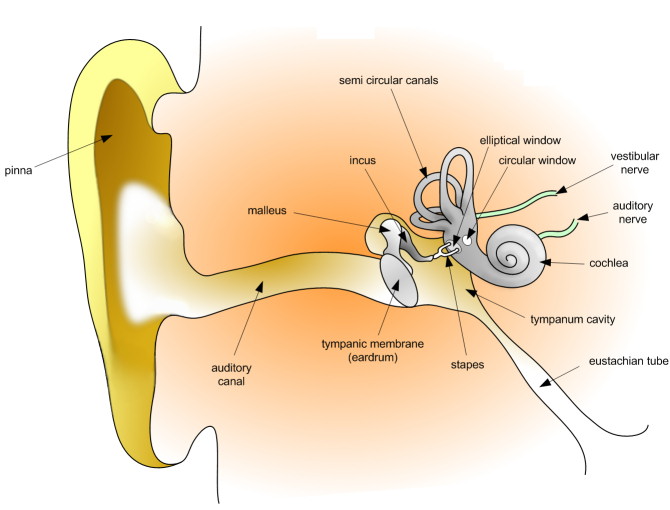 Sound waves enter the ear, go down the ear canal (auditory), and hit the
eardrum, which vibrates. The vibrations from the eardrum pass to the
three ossicles (bones called the malleus (hammer), incus (anvil) and
stapes) in the middle ear. These occicles amplify the vibrations, which
are then picked up by small hair-like cells in the cochlea; they move as
the vibrations hit them, the movement data is sent through the auditory
never to the brain. The brain processes the data, which we interpret as
sound.
Sound waves enter the ear, go down the ear canal (auditory), and hit the
eardrum, which vibrates. The vibrations from the eardrum pass to the
three ossicles (bones called the malleus (hammer), incus (anvil) and
stapes) in the middle ear. These occicles amplify the vibrations, which
are then picked up by small hair-like cells in the cochlea; they move as
the vibrations hit them, the movement data is sent through the auditory
never to the brain. The brain processes the data, which we interpret as
sound.
A patient with mild hearing impairment may have problems understanding
speech, especially if there is a lot of noise around, while those with
moderate deafness may need a hearing aid. Some people are severely deaf
and depend on lip-reading when communicating with others.
People who are profoundly deaf can hear nothing at all. In order to
communicate spontaneously and rapidly with people, they are totally
reliant on lip-reading and/or sign language. People who are born deaf find lip-reading much harder to learn compared
to those who became hearing impaired after their had learned to
communicate orally (with sounds).
Deafness can be an impairment one is born with, caused themselves, happened while going through another illness like chicken pox or AIDS, or occurred after a severe accident. Whatever the reason, treatment depends on the severity of the hearing impairment. Hearing loss is when one can still hear, but the quality is diminished while deafness is when the sound is completely diminished no matter how amplified a sound may be. Sensorineural hearing loss is incurable. When the hair cells in the
cochlea are damaged, they cannot be repaired. However, various
treatments and strategies can help improve the patient's quality of
life. Hearing aids are the most common treatments because while they do not cure deafness, they help amplify the sound so that there is a little bit of hearing.
Sources:
Source 1
Source 2

No comments:
Post a Comment